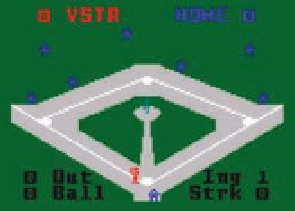Game Development Reference
In-Depth Information
Atari 2600 (1977)
Unlike other self-contained home game consoles, which had limited
functions, this version contained a complete central processing unit
(CPU). This was combined with a chip for random-access memory (RAM),
or short-term memory, and input/output (I/O). Atari also designed a
display and sound chip called the TIA (Television Interface Adaptor),
and added a fourth chip for CMOS (semiconductor) function. This four-
chip design allowed Atari to make units inexpensively. The inclusion of
RAM meant that players could change the game by loading dif erent
programs.
The sounds that the VCS (later known as the 2600) makes are quite
quirky, raw and unlike anything anyone had ever heard come out of a TV.
To give you an idea of the state of its audio capabilities, the 2600 featured
2 channels of 1-bit monaural sound along with a 4-bit volume control.
You read right, 1 whole bit!! Nevertheless, to game ai cionados the sound
of the Atari 2600 is immediately recognizable, and especially sought after
by lovers of chiptune music.
Mattel Intellivision (1980)
Intellivision was Mattel's i rst and basically only serious foray into the
home console wars. The i rst 16-bit game console, Intellivision, of ered
players keypad and controller entry to interact with games. Though
the product sold moderately well, its success was hobbled by dii cult
controllers and by announced add-ons that failed to appear or did not
function as advertised. One well-known game for the Intellivision was
a baseball game,
MLB
, that gave verbal feedback through synthesized
voices that called strikes and outs. It had a very limited and baseball-
centric vocabulary, but it was huge at the time and set the stage and
standard for all sports games to come—after all, how could you have a
game without a play-by-play announcer?
The
MLB
baseball game for Intellivision
featured primitive play-by-play
commentary—a i rst of its kind.
The Golden Age of the Arcade
It is worth mentioning that at the same time as these i rst home game
consoles were happening, arcade video games were entering their
golden age, which continued well into the 1980s. Graphic quality
increased, and dedicated and sophisticated sound chips appeared.
A new and innovative style of music was emerging from the simple
1s and 0s inside these machines that would go on to af ect how
composers would create music in the future.


































